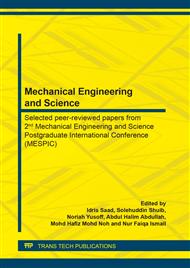[1]
J. Pan, W. Li, Algorithm of implementing 3D calibration board-based camera calibration,, University of Science and Technology of China, (2007).
Google Scholar
[2]
B-L. Robin, Participatory Ergonomics: Evidence and Imple-mentation Lessons,, Applied Ergonom-ics (2018).
Google Scholar
[3]
S. Gavriel, Handbook of Human Factors and Ergonomics,, John Wiley & Sons, Inc., 4th Edition (2012).
Google Scholar
[4]
H. S. Loo and R. Stanley, Ergonomics Issues in Malaysia,, Science Publications (2012).
Google Scholar
[5]
Georgios, Center for Risk and Safety in the Envi-ronment (CERISE),, European University Cyprus (2017).
Google Scholar
[6]
Z. Dong, C. Jiayu and Lv. Chuan, A method for integrating ergonomics analysis into maintainability design in a virtual environment,, International Journal of Industrial Ergonomics, Vol 54, Pg. 154-163 (2016).
DOI: 10.1016/j.ergon.2016.06.003
Google Scholar
[7]
T.Fourniera, L.Tibèrebe, C.Laporte, Eating patterns and prevalence of obesity. Lessons learned from the Malaysian Food Barometer,, Appetite, Volume 107, Elsevier LTD, (2016).
DOI: 10.1016/j.appet.2016.08.009
Google Scholar
[8]
J. Pansiot, Z. Zhang, B. Lo and G. Z. Yang, WISDOM: wheelchair inertial sensors for displacement and orientation monitoring,, IOP Publishing Ltd. (2011).
DOI: 10.1088/0957-0233/22/10/105801
Google Scholar
[9]
Nor Muaza Nor Adnan, Biomechanical analysis using Ki-novea for sports application,, IOP ebooks, (2018).
Google Scholar
[10]
O. Scott and T. Erin, Ergonomics and Design A Reference Guide,. Allsteel Inc. (2006).
Google Scholar
[11]
M. Vito, A. Emmanuele, Real time Rula assessment using Kinect V2 Sensor,, Applied Ergonomics, (2017).
Google Scholar
[12]
H. H. Nur Amirah, A. N. Ahmad Faiz, Measuring Ankle An-gle and Analysis of Walking Gait using Kinovea,, iMEDiTEC, (2017).
Google Scholar
[13]
C. Diana-Margarita, R. T. Juan, A multiple camera calibration and point cloud fusion tool for Kinect V2,, Elsevier, (2017).
Google Scholar
[14]
Md. Z. Raemy and M. R. Jafri, Financial Impact and Causes of Chronic MSD Cases in Malaysia Based on SOCSO Claims Record,, Advances in Intelligent Systems and Computing, (2018).
DOI: 10.1007/978-3-319-96083-8_7
Google Scholar
[15]
Health and Safety Executive, Work-related Musculoskeletal Disorders (WRMSDs) Statistics in Great Britain 2017,, Health and Safety Executive, Vol. 1(1), p.22, (2017).
Google Scholar
[16]
C. Berlin, C. Adams, Production Ergonomics: Designing Work Systems to Support Optimal Human Performance,, Dig-ital Human Modelling, Ubiquity Press, December (2015).
Google Scholar
[17]
A. Nor Hazana, W. Eta, S. Alina, Workplace Ergonomics and Employees' Health: A Case Study at Automotive Manufactur-er,, International Conference on Industrial Engineering and Operations Management, Kuala Lumpur, (2016).
Google Scholar
[18]
B. Georgios, Center for Risk and Safety in the Environment (CERISE),, European University Cyprus, (2017).
Google Scholar
[19]
T. Renran, G. D. Vincent, M. John A, Effecting Validity of Ergonomics Analysis During Virtual Interactive Design,, V.G. Duffy (Ed.): Digital Human Modeling, HCII., Springer-Verlag Berlin Heidelberg, p.988 – 997, (2007).
DOI: 10.1007/978-3-540-73321-8_111
Google Scholar
[20]
M. Hassall, T. Xiao, P. Sanderson, Human Factors and Ergo-nomics,, International Encyclopedia of the Social & Behav-ioral Sciences: Second Edition, Pg. 297-305, (2015).
Google Scholar


